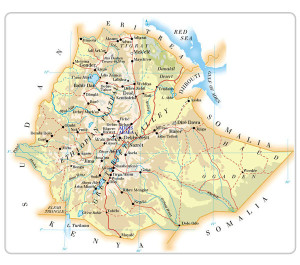Ethiopia, officially known as Federal Democratic Republic of Ethiopia is a country located in the Horn of Africa (northeastern Africa). It is surrounded by Eritrea, Djibouti, Somalia, Sudan, South Sudan and Kenya. It is the 2nd most populous country in Africa.
HISTORY
Conventionally, Ethiopian history begun with the visit of queen of Sheba, allegedly from Ethiopia, to Solomon, king of Israel in the tenth century BC: hence the reference to Ethiopia’s 3000 years history that we claim so often. Aside from the fact that this association has scarcely any scientific basis, it represents too short a view of the Ethiopia’s past. Archeological and linguistic research in recent years has made possible and necessary the adoption of a longer and more scientific perspective. 
Ethiopia and its history is the story of Africa at its inception. Archeologists and anthropologists commonly count Ethiopia as the origin of human. In 1994 the oldest human remains ever were discovered here. The 4.4 million old bones of Homo Ramidus Afarensis, were found in Ethiopia’s Afar region – the previous record was held by “Lucy” or “Dinkinish” (Amharic for “wonderful”), who at 3.4 million years was a relative youngster As a proof of its long history Ethiopia has many historical places. Axum is Ethiopia’s most ancient city and the site of many remarkable monolithic stone stelae. At Lalibela there are remarkable rock-hewn monolithic churches.
The 17th century the city of Gondar and the 9th century city of Harar are the other historical attractions. In addition to these there are many age-old churches, monasteries and mosques with rich collection of relic in different parts of Ethiopia. Many colorful festivals are also additional attractions.
The discovery in 1974 G.C of the earliest hominid in the Afar desert, named LUCY can be a very good example. This female ancestor of the human race was dated to 3.5 million years ago.
As a proof of its long history Ethiopia has many historical places. Axum is Ethiopia’s most ancient city and the site of many remarkable monolithic stone stelae. At Lalibela there are 11 remarkable rock-hewn monolithic churches.
The 17th century the city of Gondar and the 9th century city of Harar are the other historical attractions. In addition to these there are many age-old churches, monasteries and mosques with rich collection of relic in different parts of Ethiopia. Many colorful festivals are also additional attractions.
PEOPLE AND CULTURE
 With a history stretching to three millennia back and with different people speaking over 83 languages and 200 dialects, it is no wonder that the mosaic of cultural diversity of Ethiopia is a major attraction and enchantment. Ethiopia is rich medley of people of different religions and customs with distinctive life styles. There are many interesting cultural traditions in Ethiopia including the nomadic culture of the people of the Omo Valley. The life style of the people has hardly changed for centuries. People still dress from animal skins, drink from calabashes and decorate with clay. It is unique, undisturbed, wild and considered to be among the most fascinating in the African continent. Traveling through this area is like traveling thousands of years back in time, providing an insight in to an Africa of a bygone age.
With a history stretching to three millennia back and with different people speaking over 83 languages and 200 dialects, it is no wonder that the mosaic of cultural diversity of Ethiopia is a major attraction and enchantment. Ethiopia is rich medley of people of different religions and customs with distinctive life styles. There are many interesting cultural traditions in Ethiopia including the nomadic culture of the people of the Omo Valley. The life style of the people has hardly changed for centuries. People still dress from animal skins, drink from calabashes and decorate with clay. It is unique, undisturbed, wild and considered to be among the most fascinating in the African continent. Traveling through this area is like traveling thousands of years back in time, providing an insight in to an Africa of a bygone age.
NATURE

Although Ethiopia is found very near the Equator, the country as a whole is far from “tropical” in the accepted sense of the term. On the contrary the elevated nature of its highlands rising to over 1,500 meters gives it a decidedly cooler climate than its geographical location seems to suggest. Visitors to Ethiopia soon discover that climate is not merely an expression of latitude, but also of altitude.
Ethiopia is a country with contrasting nature, from the snow capped peaks of the Semien Mountains to the arid lands of low land desert, the Denakil Depression. Its unique landscape makes Ethiopia to have more endemic flora and fauna than any other regions in Africa. No other aspect of Ethiopia’s biology typifies its unique situation more than 800 species of birds are discovered in the region of which more than 16 species are endemic.
